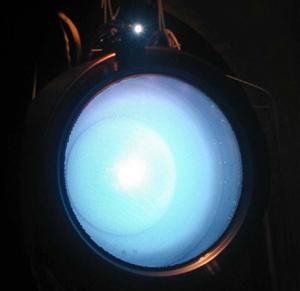Mon, Jul 01, 2013
Advanced Ion Engine Has Run Continuously for 48,000 Hours
A NASA advanced ion propulsion engine has successfully operated for more than 48,000 hours, or 5 and a half years, making it the longest test duration of any type of space propulsion system demonstration project ever. The thruster was developed under NASA's Evolutionary Xenon Thruster (NEXT) Project at NASA's Glenn Research Center in Cleveland. Glenn manufactured the test engine's core ionization chamber. Aerojet Rocketdyne of Sacramento, CA, designed and built the ion acceleration assembly.

The 7-kilowatt class thruster could be used in a wide range of science missions, including deep space missions identified in NASA's Planetary Science Decadal Survey. "The NEXT thruster operated for more than 48,000 hours," said Michael J. Patterson, principal investigator for NEXT at Glenn. "We will voluntarily terminate this test at the end of this month, with the thruster fully operational. Life and performance have exceeded the requirements for any anticipated science mission."
The NEXT engine is a type of solar electric propulsion in which thruster systems use the electricity generated by the spacecraft's solar panel to accelerate the xenon propellant to speeds of up to 90,000 mph. This provides a dramatic improvement in performance compared to conventional chemical rocket engines. During the endurance test performed in a high vacuum test chamber at Glenn, the engine consumed about 1,918 pounds of xenon propellant, providing an amount of total impulse that would take more than 22,000 pounds of conventional rocket propellant for comparable applications.
"Aerojet Rocketdyne fully supports NASA's vision to develop high power solar electric propulsion for future exploration," said Julie Van Kleeck, Aerojet Rocketdyne's vice president for space advanced programs. "NASA-developed next generation high power solar electric propulsion systems will enhance our nation's ability to perform future science and human exploration missions."
(NEXT ion thruster image provided by NASA.)
More News
Outboard Section Of The Right Wing And The Right Flap Separated In Flight And The Airplane Impacted A Farm Field Analysis: The pilot was approaching his destination airport under i>[...]
Final Approach Fix The fix from which the final approach (IFR) to an airport is executed and which identifies the beginning of the final approach segment. It is designated on Gover>[...]
"Our choice of when to respond, how to respond and on which targets to respond is a consideration that we make every time... Netanyahu also noted that anyone attacking Israel &ldqu>[...]
Estimated (EST) When used in NOTAMs “EST” is a contraction that is used by the issuing authority only when the condition is expected to return to service prior to the e>[...]
Aero Linx: Coalition of Airline Pilots Associations (CAPA) The Coalition of Airline Pilots Associations (CAPA) is the world’s largest pilot trade association representing ove>[...]
 NTSB Final Report: Cessna 177B
NTSB Final Report: Cessna 177B ANN's Daily Aero-Term (05.08.25): Final Approach Fix
ANN's Daily Aero-Term (05.08.25): Final Approach Fix Aero-News: Quote of the Day (05.08.25)
Aero-News: Quote of the Day (05.08.25) ANN's Daily Aero-Term (05.09.25): Estimated (EST)
ANN's Daily Aero-Term (05.09.25): Estimated (EST) ANN's Daily Aero-Linx (05.09.25)
ANN's Daily Aero-Linx (05.09.25)



